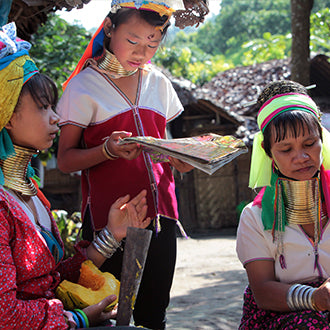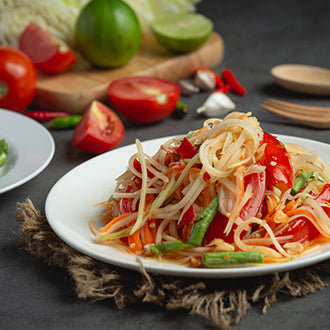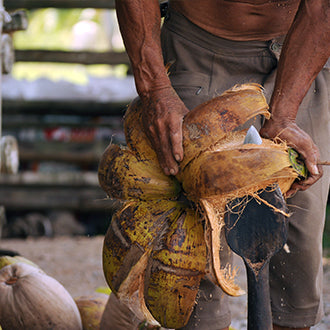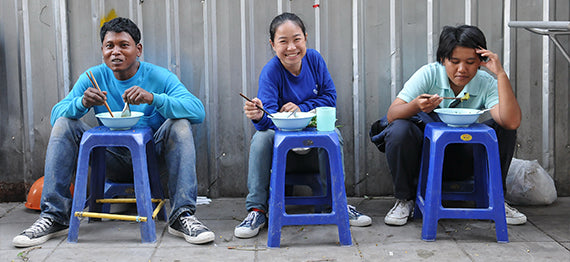My shopping cart
Your cart is currently empty.
Continue Shopping
Thai food is gaining popularity worldwide because of the variety of cuisines, its exceptional taste, and the uniqueness of its character. According to the Tourist Authority of Thailand, “The special quality of Thai food is its ability to reflect three key values – nutritional, cultural, and medical – with the use of fresh ingredients, well-trained natural talent in cooking methods and presentation techniques, and the generous use of herbs and spices.
Thai food is a harmonious combination of tastes and medicinal qualities, as the ingredients are mainly vegetables and herbs, such as lemon grass, galangal, capsicum, basil, and garlic, which not only give out enticing aromas, but also increase the health benefits.”
While Thai food is well known for its spiciness, its essence is actually in the art of balancing four prominent flavors: salty, sweet, sour, and spicy, in which the level of spiciness also depends on the type of Thai food. Thai cuisines are varied in tastes and styles depending upon the area or region of the country that the dish originates from. Regional ingredients, cooking techniques and the favorite flavors of the local people define local dishes and shape their distinctive tastes and charms.
But a common characteristic you can notice is the use of fresh herbs and spices and fish sauce as a main condiment added to almost every main dish.

Thai cuisine in the North of Thailand is influenced by the region’s neighbors, Burma and Laos. This is reflected in the consumption of main dishes with sticky rice or famous dishes like Khao Soi or Kaeng Hangle.
Also, a cool climate all year round in this region inspires dishes which use ingredients that keep your body warm and boost your energy. Some samples are Kaeng Hangle using pork belly, Kaeng Kradang using pork knuckle mixed with spices and Khao Soi using coconut milk as their main ingredients. The locals also use a lot of natural exotic herbs to create some unique local dishes. The Northern food in general tastes salty rather than sweet, mildly hot, and requires a lot of fresh vegetables, smoky grills and herb-rich curries.
Some famous Northern Thai cuisine includes: Khao Soi (egg noodle with yellow curry, served with chicken, pork or beef), Kaeng Hangle (a pork curry flavored with ginger, turmeric, and tamarind), Sai ua (Northern style grilled pork sausage with herbs and spices), Nam Prik Ong (a dip with minced pork, chili and tomatoes).

The Northeastern region, known locally as Isan, cuisine is famous for its unique dishes and pungent taste which is heavily influenced by Lao cuisine.
One of the most distinctive ingredients in Isan food is Pla Ra or fermented fish that the locals use to season their dishes or use as dipping. Pla Ra has a salty and sour taste, with a very strong smell, which may be unpleasant for some people, but it cannot be denied it is a part of Isan food that makes it outstanding and popular nationwide. Isan food rarely uses coconut milk in cooking, so most dishes are light and fresh, but burning hot and spicy tastes.
Some famous Isan dishes are Som Tam (Green papaya salad), Nam Tok (spicy grilled pork or beef salad), Grilled Chicken, Lap (Minced pork salad) and Sup Nor Mai (Hot and Sour Bamboo Shoots Salad), served mostly with streamed sticky rice.

Central Thai Cuisine is the most common food in the country and most of the Thai classic dishes which are known worldwide are from this region, like Pad Thai, Tom Yam Soup or Green Curry Chicken.
Chinese and Indian cuisine play a major influence for the food in this region, for example, stir-fries, noodle and curry dishes. The Central food palate in general is a mellow taste of sour, salty, spicy and sweet. One of the major ingredients used in Central Thai cuisine is coconut milk, and other condiments like soy sauce, fermented bean paste, and oyster sauce.

Seafood are signature dishes of this peninsular region. Due to an abundance of coconuts and sugar palms in the South, the local cuisine makes heavy use of coconut milk and palm sugar.
The food palette in this region is also known for hot and deeply spicy taste since there is a lot of curry paste and chili in the dishes.
Some famous dishes from the South: Massaman Curry (Indian-Malay style curry with Chicken and Potatoes) , Panang Curry (A thick red Thai curry made with peanuts and spices), Khua Kling (Southern dried-friend curry with minced pork), Satay (Marinated grilled skewers with peanut sauce for dipping)
